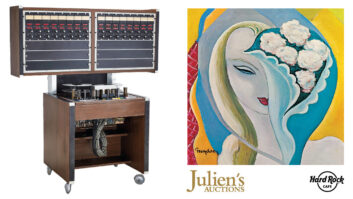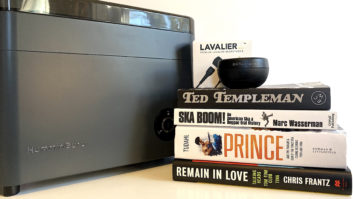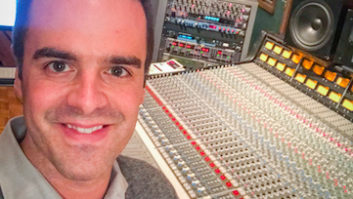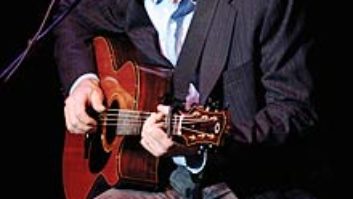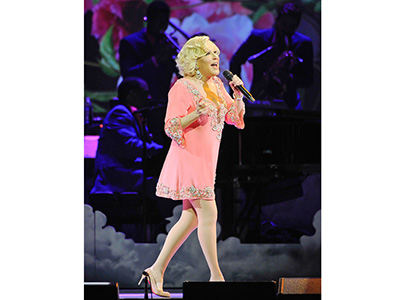

Bette Midler, The Harlettes and her 12-piece band performed her Divine Intervention 2015 show at the SAP Center in San Jose in late May. Photo: Steve Jennings
Bette Midler, The Divine Miss M, embarked on her first major tour in a decade with a 30-city tour in support of her latest album release, It’s The Girls!, her tribute to the girl-group pop music of the ’60s and beyond. The Divine Intervention Tour 2015 touched down in arenas throughout the U.S. in May and June, capped off with stops at Madison Square Garden and Barclays Center in New York City before heading to the UK for the month of July. More than simply a concert, the 2-hour show can be described as a full-scale musical production, serving up tightly choreographed Broadway- or Las Vegas–style entertainment complete with set and costume changes and skits that complement Midler’s 25 songs, drawn from It’s The Girls! and from her vast recorded catalog stretching back to the 1970s.
Joining Midler onstage are her backing vocalists, The Harlettes—Carol Hatchett, Nicolette Hart, and Kyra DaCosta—and a 12-piece big band under the musical direction of Morris Pleasure on piano and keyboards. The band is comprised of a stellar cast of top touring and recording musicians: Sonny Emory (drums), Sam Sims (bass), Darrell Smith (keyboards), Taku Hirano (percussion), Jeff Pevar (guitars), Tariqh Akoni (guitars), Adrian Crutchfield (saxes, flute), Mike Eyia (woodwinds), Mike Cottone (trumpet), Chris Bautista (trumpet) and J.P. Floyd (trombone).
The entire effort was launched with four weeks of music rehearsals at GMT Studios in Los Angeles, followed by one week of production rehearsals at the Los Angeles Memorial Sports Arena, followed by one week of rehearsals at Hard Rock Live in Hollywood, Florida, where the tour opened on May 8. Mix caught Midler’s performance in late May at the SAP Center in San Jose, Calif.

Solotech systems engineer Fred Cantin (left) and front-of-house engineer Steve Guest at the DiGiCo SD7 console at FOH. Photo: Steve Jennings
Mixing audio for Midler and her ensemble at front-of-house is veteran engineer Steve Guest, who has a history of working with Midler and musicians in her band. “I took over mixing her Experience The Divine tour in 1994,” Guest recalls. “I was the backup FOH engineer mixing the last months of her ‘The Showgirl Must Go On’ run at Caesars Palace in Las Vegas. I’ve known her core rhythm section—Sonny, Sam and Darrell—since around 1991.”
Sound company Solotech, with a U.S. office in Las Vegas, is supporting this tour by providing video and audio equipment including an L-Acoustics arena system comprising 14x K1 main left and right P.A. plus 4x K2, which acts as downfill; 14x K2 for left and right side hang; flown subs, which are 8x K1-SB per side; deck subs, which are 4x SB-28 per side; and 8XT and 12 XT coaxial loudspeakers as front fills. In addition, the Divine Intervention Tour is using two DiGiCo SD7 digital consoles with Stealth Digital Processing, one at front-of-house and one at monitors.
“The monitor console was chosen first,” Guest explains. “The SD7 has enough output capability and flexibility to accommodate everyone, including the backline guys, to be on stereo IEMs plus some stage wedges. For FOH, rather than having a mic splitter and two different stage rack setups just to accommodate a different console choice for me, I went with an SD7 as well. We needed two stage racks—around 100 inputs, which are gain shared between consoles. So inputs are seeing just one load and without a mic splitter in line there are fewer connections and points of failure, it’s more reliable, and easier to troubleshoot. I have a Waves [plug-in] package and redundant servers, but I’m only using a few things: the dbx 160 as a bus compressor; the PuigChild compressor, modeled on a Fairchild, also as a bus compressor; and I use the TrueVerb reverb for the horns.”
Emory’s drums serve as an anchor for the music and for Guest’s mix. “Sonny is so solid, consistent, and such a great player you can’t help but to build a band mix around him,” Guest says. “It’s very much a big band, and there are times when it feels like a classic big band—and I like that! [Laughs] It adds to the whole classic feel of it, when the horn section kicks up and comes across like a big band. Mixing those guys is not too far removed from mixing [saxophonist] Dave Sanborn’s band [Guest has often worked with Sanborn since 1991]. It’s a similar feel. You just want to hear what’s going on, and they’re such great players and want to bring all that out. So I kind of approach it the same way. And [Midler’s] voice is just beautiful, and I sit that on top of [the mix].”

Bette Midler and The Harlettes
Photo: Steve Jennings
Midler’s voice is, to be certain, the main focus of the show and of the FOH mix. “The big picture is Bette,” Guest says. Midler’s vocal chain begins with a DPA d:Facto capsule mounted on a Shure Axient AXT-200 transmitter, used with Shure AXT-400 receivers that output AES directly into the stage rack. “So it goes digital right from the capsule, right to the console, so there’s no conversion involved; it goes right from the capsule to the fader. Normally wireless stuff has its own set of problems, but the Axient stuff on AES right into the system—beautiful.”
Guest says that he chose the d:facto as the best match for Midler’s voice. “She was using another mic when I came in on the Caesars Palace gig, and I didn’t feel I was getting the combination of warmth and clarity I wanted from it,” he says. “When I got the nod for this tour I played around with some other choices and ended up with the DPA d:Facto. I didn’t seem to need to wrestle with the lower midrange like I do with a lot of other vocal mics.
“I don’t use any special plug-ins on her voice,” Guest notes. “The SD7’s onboard EQ and dynamic control stuff is great—compressors with side chain access and filtering, dynamic EQ, and de-essers. I use very little in the way of vocal effects so most of [the reverb] you’re hearing is definitely room acoustics. But I do have an outboard Bricasti Design M7 I use lightly just for her voice. In an arena there’s enough natural reverb flying around that I don’t really need to add that much to it.”
Headset vocal mics also factor into this production, to accommodate the movement of Midler and The Harlettes throughout both sets in the show. “We started with DPA [4066] headsets for Bette and the Harlettes but switched to the Sennheiser HSP4 headset for Bette,” Guest says. Additionally, the horn players are outfitted with Shure Beta 98H/C clip-on instrument mics, to enable them to participate in choreographed numbers. “I didn’t want to have two sets of microphones just for the horn section, so I just left them as wireless,” Guest says. “I mean, we’re already at over 100 inputs!” [Laughs]

Monitor tech Alexandre Bibeau (left) and monitor engineer Martin Paré at the DiGiCo SD7 at monitors. Photo: Steve Jennings
Monitor engineer Martin Paré works for Solotech, and was originally hired for the Divine Experience Tour as the monitor assistant. When the tour’s original monitor engineer had to leave for personal reasons, Paré was asked to step in. “I have an assistant, Alexandre Bibeau, who is a great help by listening to the band communication and relaying to me [whether they need] any fixes.”
As noted, Paré is also mixing on an SD7. “I love everything about this console,” he says, “the sonic quality, ease of use and all the I/O that you ever need in one sleek package.” His monitor setup includes the Shure PSM1000 Personal Monitor System rackmount dual-channel, networkable transmitter and Shure Axient wireless mic system. Midler relies on six L-Acoustics 12XT coaxial loudspeakers across the front of the stage and three KUDO per side for side-field monitoring.
“Midler is using one in-ear, the JH Audio Ambient FR, in her left ear to hear her voice, piano, drums and The Harlettes,” Paré explains. “It’s about the same in the wedges, and a full band mix in the side fields. During rehearsal I was using the Waves TrueVerb for effects on her voice, but since she’s only using one ear, and depending on how the arenas sound, I’ve removed the effects from her mix to get it more tight and coherent.”
This tour marks Paré’s first time working with Midler. “Miss Midler is a real professional,” he says. “She’s a great artist and an amazing singer. During the show I only listen to her so I don’t have much time for the band.”
